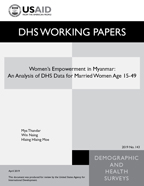
Abstract:
ABSTRACT
This study investigated women’s empowerment
among currently married women age 15-49 in
Myanmar from socioeconomic and demographic
perspectives, based on data from the 2015-
2016 Myanmar Demographic and Health Survey
(MDHS). The dimensions of women’s empowerment
were categorized into two parts: women’s
control over own earnings, and women’s
participation in household decision-making
(decisions on major household purchases,
visits to family or relatives, women’s own
health care, and well-being of their
children). These two dimensions were
converted into an index of women’s
empowerment. Binary logistic regression was
used, by means of odds ratios, to assess the
relationship between women’s level of
empowerment and their socioeconomic and
demographic characteristics. Overall, the
results found a higher empowerment level
associated with women’s employment, increased
age, urban residence, higher educational
attainment, higher wealth quintile, and lower
level of husband’s education. Also, women
with one or two children, as well as women
with three or four children, were more likely
to have a high level of empowerment, compared
with women with no children. About three-
fourths of the women in the sample lived in
rural areas. Among women in rural areas,
those found to have a higher level of
empowerment had more education, were
employed, and had higher household income.
Generating employment opportunities for women
and educating women are important factors
that can lead to an increase in women’s
income, and thus help raise levels of women’s
empowerment.
 Women's Empowerment in Myanmar: An Analysis of DHS Data for Married Women Age 15-49 (PDF, 590K)
Women's Empowerment in Myanmar: An Analysis of DHS Data for Married Women Age 15-49 (PDF, 590K)
